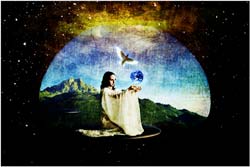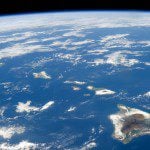This distinction has significant implications for the "Soul" of Gaea.
 The Soul of Nature
The Soul of Nature
If we accept the unity of all Earthly life as a single vast superorganism, the assumption of a planetary consciousness is as inevitable as the recognition of sentience among ourselves and other living creatures. This is the arena where consideration of the Gaia Thesis in the scientific community has come up against a wall.
The Great Divide between the physical sciences and metaphysics was created in the 1660s at the establishment of the Scientific Academy, which mandates that any consideration of sentience in Nature is taboo. Even in the realm of human consciousness, the field of Psychology has been strongly affected by Behaviorism, which refuses to acknowledge even the sentience of the scientists themselves! Thus, in order to receive any serious consideration and scientific acceptance of his "Gaia Hypothesis," it was necessary for Lovelock to downplay and even disregard any implications that his "Gaia" may have any sort of collective sentience or intelligence. This crucial omission of what is, after all, ultimately the most relevant aspect of the entire thesis, was not necessarily of Lovelock's own choosing. In corresponding with me, Lovelock made reference to Teilhard de Chardin (1881-1955), the great Jesuit paleontologist who embraced a similar view from a Christian perspective. Chardin posited the origination of life as the "Alpha Point," with a corresponding ultimate coalescence of planetary consciousness as the "Omega Point."
The idea that all life or all consciousness is interconnected is one of humanity's most enduring spiritual traditions; indeed, it is the very essence of what is called "The Perennial Philosophy." The intrinsic spirituality found among all peoples, no matter how remote or isolated, is rooted in an apprehension of a co-existent and pervasive realm of Gods and Spirits. This universal animism, pantheism, and religious theology among all human cultures supports the thesis of sentience existing at scales beyond that of the human individual, just as our individual consciousnesses operate at a vaster scale than that of our component neurons. Human groups as various as the Iroquois, the Sufis, and Western European Freemasons all incorporate this principle into their belief structures. References to it can be found in ancient documents of the classical world, both East and West. It is a compelling idea, spanning both millennia and the vast complexity of human cultures.
Carl Jung coined the term "Collective Unconsciousness" to refer to such a global mind; and Teilhard de Chardin described it as the Noosphere -- a sheath of intelligence for the Earth, and the inevitable extension of the planetary biosphere. But the true heart of this understanding is found in the alchemical mystical concept of Anima Mundi -- "The Spirit of the Earth." This term is nothing less than a medieval rephrasing of the most ancient and primordial thealogical premise of divinity as Mother Earth, Mother Nature, Gaea.
A New Planetary Mythology
Al Gore has recently raised public awareness of global warming and our escalating environmental crises. Industrial pollution is creating a greenhouse effect, causing unprecedented storms and worldwide droughts. Fifty percent of our forests are gone, as are 90 percent of large ocean fishes. Three million people a year die from air pollution, and 25 million are environmental refugees.
The problems are so vast and the politics of greed and corruption are so complex and entrenched that it will truly take a miracle to transform such global destruction. The only thing that can save us is a total and electrifying change of consciousness. Nothing short of a worldwide realization of planetary awareness will move us as a planetary people to a new way of living, to sustain and heal our Mother, the Earth. We must first believe that it is possible to make this shift in consciousness.
Mythologist Joseph Campbell suggested that the Earth viewed as a whole may be the symbol for a new planetary mythology. From the moment that the people of Earth achieved the ability to observe the image of our planet spinning in all Her radiant blue-and-white splendor through the black velvet night, many of us have felt an almost physical urge toward unity. We inevitably begin to think of ourselves as one planet, one infinitely diverse, responsive, and sustainable organism.
After four billion years of evolution, we now see Gaia mighty yet vulnerable against the starry heavens. It is this awareness that calls to us and touches our human hearts. Something is developing, hatching, unfolding. We are becoming part of a self-aware mind capable of contemplating its own existence. Gaia developed increasingly complex eyes in order to contemplate Her own image. And now, having seen Herself through our satellite eyes, She is awakening to consciousness. What is struggling to be born is a truly planetary - Gaean -- metaphor that invites people of all traditions in our divided world to know themselves as children of the same Mother -- Gaea Herself, Mother Earth.




